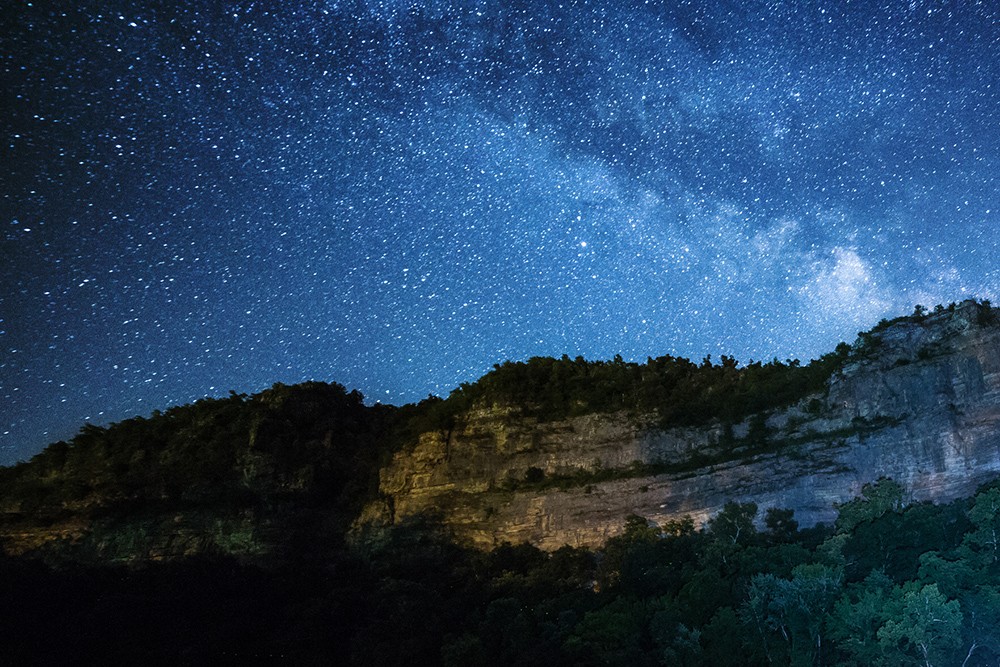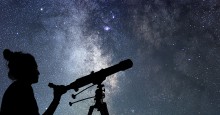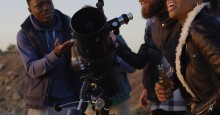
Stars in the night sky. Photo ID 43577733 © Benjamin King | Dreamstime.com
Clusters of stars glitter in the night sky above natural parks, creating displays far more impressive than any holiday decorations or city lights.
Late Winter and early Spring are great times to discover off-season solitude and experience an overwhelming sense of awe at the vast array of bright stars. During these least-visited months, you and your family can get reenergized by the wonder and peace of the wilderness.
The National Park Service has a special “Night Skies” website page dedicated to helping stargazers enjoy all the resources of the many International Dark Sky listed locations, ranger-led stargazing tours, activities and special stellar events to help plan your trip.
Check out the internet for the many excellent astronomy and “Space Tourism” sites that give directions and guides for stargazing at your location and trip dates. Note any expected solar flares for the occurrence of the Northern Lights (Aurora Borealis) or meteor showers that might enliven your adventure.
Consider packing a tent and heading to one of these destinations for stargazing and outdoor recreation this pre-spring season. It is affordable and enjoyable--a memorable adventure your family will never forget.
The lack of light pollution and smog surrounding National Parks makes them an ideal spot for stargazing. Here are tips and sights to look for, with a selection of parks famous as great places for viewing incomparable celestial sights!
Suggestions for stargazers

Woman with telescope.
Stargazing is often a group activity, and the National Parks Service offers the following etiquette suggestions and packing advice:
- Be patient. It can take around half an hour for our eyes to fully adjust to very low light conditions.
- No white lights. Use red lights, which can be made by covering the lens with red cellophane, tape, red fabric or red construction paper. Most outdoor stores sell red lights and red headlamps.
- Turn off the smartphone. They give off artificial light.
- Bring food and water. But don’t snack around telescopes--they are fragile and expensive.
- Bring warm clothes, blankets and lightweight chairs. Expect varied weather in this season; a folding chair will ease waiting and make telescope viewing more comfortable.
- Restrain your pet. Leashes can get tangled in telescope tripods, causing tripping hazards and potential for expensive damage.
Telescopes
A good telescope can bring the stars close and greatly enhance your stargazing experience, but are they a good investment for a beginner? There are many kinds and qualities of telescopes available for beginners or experienced astronomers, but they tend to be a pricey investment. A great solution is to rent a telescope for your trip; rental companies usually rent by the day and may have several types of telescopes to try.

Friends using telescope.
There are many internet resources and videos that instruct about telescope usage, types and choices for any age and experience level. A search online has a plethora of videos to watch.
If you choose to rent a telescope, have the rental company show you how to use it. You can also search for tips and instructions for the specific telescope that you choose.
Telescope tips:
- Lower your eye to the eyepiece.
- Avoid handling the telescope, which can disrupt the focus or change the field of view.
- When in doubt, let the scope operator or salesperson know and they can check/adjust it for you.
Constellations and Stellar Landmarks
Orion, the Hunter
Perhaps winter’s most prominent constellation. Three stars in the southern sky form Orion’s belt, and three additional stars outline his sword. The Orion Nebula, a massive stellar cloud made of dust and gas, is visible with a telescope.
Sirius, the Dog Star
Follow the trace of Orion's belt down and to the left to encounter Sirius, the brightest star. Sirius lies in the constellation Canis Major, the Great Dog.
The “Spring Triangle”
This constellation is an outline formed by three bright stars from three prominent spring constellations: Regulus in Leo, Arcturus in Boötes, and Spica in Virgo.
The Big Dipper or “Ursa Major,” the great bear
The Big Dipper was also known to slaves as “the drinking gourd” and provided a sure way to travel north. The last two stars in the cup of the Big Dipper are known as the “pointers,” because a line drawn north will point to the North Star, which is a dim star, but important because it never changes its position, which is true north.
The Little Dipper constellation, or “Ursa Minor,” the little bear
Used in navigation to find true north, This grouping of seven stars hangs off the north star like a pothook. To locate this constellation, find the Big Dipper and follow the two “pointer” stars on the cup to the North Star. The little dipper whirls around the north star as the earth turns.
The Lyrid meteor shower
The average Lyrid shower produces 15 to 20 meteors per hour. Some years, the Lyrid meteor shower intensifies and can produce up to 100 meteors per hour in what's called an "outburst." Peak viewing is April 16-25 every year, with the best opportunities to see the luminous trains of dust from 10:30pm on and right before dawn. Avoid trying to see meteors when the full moon is dominant; a little research on moonrise will give you a better chance to see the show!
The Northern Lights
Late winter and early spring give good viewing conditions to see these moving and waving “curtains of light,” with long nights and crisp, cold atmospheric conditions. Predicting when they will appear is impossible! The Aurora Borealis is formed around the north pole’s magnetic fields and is dependent upon solar wind and flares. Predictions can only be made within a couple hours of onset. Though the Aurora has been seen during intense solar storms as far south as New Mexico and Oklahoma, they are usually associated with the northern states, where they are the brightest.
National Parks known for night sky star displays
Big Cypress National Preserve, Ochopee, Fla.
Water isn’t the only part of the swamp that’s dark--the night sky above the Florida Everglades can be pretty inky as well.
Located in Florida’s famous marshlands, Big Cypress National Preserve is specifically geared toward stargazers. Designated by the International Dark-Sky Association as an International Dark-Sky Place, the south Florida hideaway is far from bright city lights and other visual pollutants.
The preserve needed to retrofit its lighting systems in order to achieve the prestigious designation, and Big Cypress joins Kissimmee Prairie Preserve State Park as International Dark Sky Places in Florida. You don’t need a telescope to marvel at the Milky Way and other sky features visible with the naked eye.
Bryce Canyon National Park: Bryce Canyon, Utah
Located in Utah’s southwest corner, Bryce Canyon National Park remains a destination for stargazers across North America.
Park rangers and volunteer astronomers host classes and seminars in a place that sees roughly 7,500 stars on a moonless night. A popular attraction is the Night Sky Program, which features multimedia shows and stargazing with telescopes.
Website: www.nps.gov/brca/index.htm
Voyageurs National Park, Minn.
Experience the northern lights and stargaze amid stunning lakes, shores and islands crusted over in natural ice sculptures.
Viewing the Aurora Borealis is a popular winter activity in this little-visited park, sheltered from Lake Superior. For the cold season, the site lists resources of private snowmobile tours, winter sports gear suppliers and guides for day trekking.
If you wish to get away from the scenic roadways to enjoy this astoundingly beautiful park, trails abound for novice to expert hiking, cross-country skiing and snowshoeing. The website has guides for viewing the northern lights, specific trail updates and featured seasonal activities.
Death Valley, eastern California and Nevada
Explore sparkling, snow-dusted dunes and vivid geologic colors towering over many walking trails. Famed among off-roaders, the park has routes accessible in the bracing cold of winter.
For stargazers, sundown offers an entirely new experience for visitors. There is no closing time at Death Valley; hiking trails are open and stargazing is a popular pastime. From the park, you can follow Highway 190 west from the lowest point in the US to a view of Mt. Whitney, the highest mountain in the lower 48 states.
Joshua Tree National Park: Joshua Tree, Calif.
This is a destination for stargazers all year long, especially on winter solstice. Stand among the sand dunes and stare at the celestial symphony.
Rocky Mountain National Park: Estes Park, Colo.
Rocky Mountain isn’t an official International Dark Sky Park like the Western Slope’s Black Canyon National Park, but the more than 12,000-foot elevation offers idyllic conditions for stargazing.
Mt. Rainier National Park: Paradise, Wash.
Close to the Seattle metroplex, Mt. Rainer is the largest active volcano in the continental US and a world away from the bright light of the city.
Spend the daylight hours skiing, snowboarding, snowshoeing and more in the park that receives more than 54 feet of snowfall every year. Besides vivid bursts of wildflowers in spring, the park is famous for night sky viewing. The Sunrise area of the park has very little light pollution and is frequently visited by star photographers and serious astronomers. Enthusiasts are friendly, and can offer tips and help. The park does not permit overnight camping in a vehicle, so dress warm and check the weather before beginning your stellar adventure!
Arches National Park: Moab, Utah
Snow blankets the desert in this Utah national park, where roughly 2,500 stars a night are visible under normal conditions. Plan ahead as snow can make some roads and trails inaccessible.
Denali National Park, Alaska
The Aurora Borealis occurs year-round in this far north Mecca for stargazers, but only is visible in the fall, winter and early spring months, during the long winter nights of the park’s arctic locale.
Visiting Denali is a memorable experience, and the park’s website caters to stargazers with articles, viewing suggestions, and weather updates.
Mauna Loa and Mauna Kea Observatory, Hawaii Volcanoes National Park
This park has several active volcanoes, and a visit to the two observatories atop Hawaii’s highest peaks is a never-to-be-forgotten trip on your Hawaiian visit. There are tours and a new Visitor’s Center atop Mauna Kea, with activities and programs for visitors. The Big Island of Hawaii enjoyed dark skies from its position in the Pacific Ocean. The high altitude of these two peaks allows for less atmospheric interference and pure and crisp star viewing.
Big Bend National Park, Texas
Listed as a “gold tier destination” and one of the top seven sites in the world for stargazing by the International Dark Sky Association, this giant of a park boasts thousands of stars visible per night. The park has wonderful hikes for day trips, hot springs to visit and abundant wildlife on show. Camping is available year round in the park; for astronomy enthusiasts who like lots of comfort, some local hotels provide a telescope for guests.
Copyright © 2024 by Sensible Driver. All rights reserved.